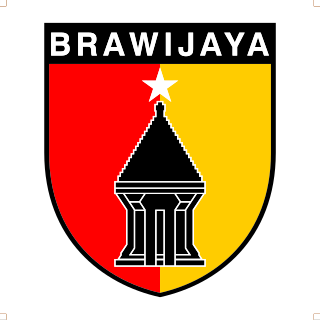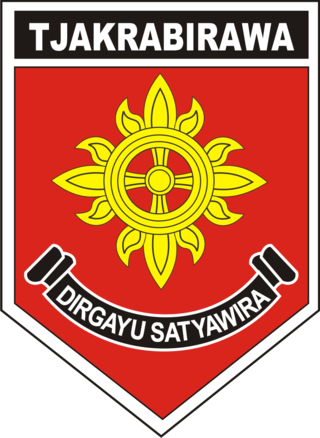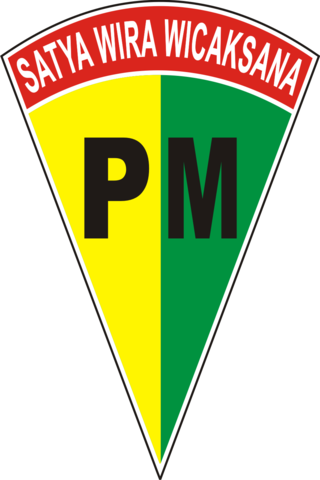
The Indonesian National Armed Forces are the military forces of the Republic of Indonesia. It consists of the Army (TNI-AD), Navy (TNI-AL), and Air Force (TNI-AU). The President of Indonesia is the commander-in-chief of the Armed Forces. As of 2023, it comprises approximately 400,000 military personnel including the Indonesian Marine Corps, which is a branch of the Navy.

Permesta was a rebel movement in Indonesia that was declared on 2 March 1957 by civil and military leaders in East Indonesia. Initially the center of the movement was in Makassar, which at that time was the capital of the province of Sulawesi. However, support for the movement in South Sulawesi gradually dissipated, forcing the headquarters to move to Manado in North Sulawesi.

The Indonesian Army is the land branch of the Indonesian National Armed Forces. It has an estimated strength of 300,400 active personnel. The history of the Indonesian Army has its roots in 1945 when the Tentara Keamanan Rakyat (TKR) "People's Security Forces" first emerged as a paramilitary and police corps.

The Indonesian Navy is the naval branch of the Indonesian National Armed Forces. It was founded on 10 September 1945 and has a role to patrol Indonesia's lengthy coastline, to enforce and patrol the territorial waters and Exclusive Economic Zone (EEZ) of Indonesia, to protect Indonesia's maritime strategic interests, to protect the islands surrounding Indonesia, and to defend against seaborne threats.

The Presidential Security Force of Indonesia is one of the Central Executive Agencies of the Indonesian National Armed Forces responsible for proximate security and escort towards the head of state and VVIP in Indonesia, which includes the President, Vice President with their immediate families, former Presidents and Vice Presidents, and visiting foreign heads of state. Paspampres is based in Jakarta, and its personnel are drawn from deputized best-chosen officers, soldiers, seamen, marines, and airmen from special forces and/or special units within the Indonesian National Armed Forces (TNI). It is commanded by a two-star military general.

The Army Strategic Reserve Command is a combined-arms formation of the Indonesian Army. Kostrad is a Corps level command which has up to 35,000 troops. It also supervises operational readiness among all commands and conducts defence and security operations at the strategic level in accordance with policies under the command of the commander of the Indonesian National Armed Forces. In contrast to its name ("Reserve"), Kostrad is the main warfare combat unit of the Indonesian Army. While Kopassus is the elite-special forces of the Indonesian Army, Kostrad as "Komando Utama Operasi" or "Principal Operational Command" still maintains as the first-line combat formation of the Indonesian National Armed Forces along with the Kopassus.

Major General (Ret) Basuki Rahmat was an Indonesian general, National Hero and a witness to the signing of the Supersemar document transferring power from President Sukarno to General Suharto.

The Jayakarta Jaya Military Regional Command is the military district of the Indonesian Army which oversees the Greater Jakarta area. It is tasked for territorial army duties, specifically for defense to the capital city region of Indonesia.

Kodam V/Brawijaya is a military region command of the Indonesian Army, as the 5th Kodam, which oversees the entire East Java Province. It traces its history to the first formation of the East Java Division in 1948.

The Kopasgat is the air force infantry and special forces corps of the Indonesian Air Force. The corps is also known as the Orange Berets from the colour of their service headgear. Kopasgat is trained to seize and defend airfields from enemy forces known as Operasi Pembentukan dan Pengoperasian Pangkalan Udara Depan , airborne operations, and other specific military operations within the scope of the Indonesian Air Force.

The Tjakrabirawa Regiment was the presidential bodyguard unit of the former Indonesian President Sukarno. It was disbanded in 1966 because of its involvement in the coup attempt of the 30 September Movement.

The Garuda Contingent, abbreviated KONGA, is a Peacekeeping unit drawn from the Indonesian military; currently titled Tentara Nasional Indonesia (TNI) and originally known as Angkatan Perang RI, that serve with the United Nations (UN). Since its first mission starting on 27 November 1956, KONGA has deployed to three continents.

Komando Daerah Militer XIV/Hasanuddin is a military command area of the Military of Indonesia. It oversees the following provinces on Sulawesi island: South Sulawesi, Southeast Sulawesi and West Sulawesi.
Panglima a military title used in Indonesia and Malaysia, and historically in the Philippines. It means 'a commander of a body of troops'. In the past it is used to call some prominent military leaders in several kingdoms, such as Panglima Polem from Aceh. In modern times it is reserved for the chiefs of the armed forces of Indonesia and Malaysia and some other posts.

Iskandar Muda Military Region Command is a military territorial command of the Indonesian Army. It has been in active service as the local division for Aceh Province. Its emblem is a white elephant, after the war elephants that served in the namesake's army during his rule as Sultan of Aceh.

Puspomad or Army Military Police Center, which all of its personnel are part of the Military Police Corps (CPM) is one of the military general technical functions of the Indonesian Army which has the role for administering administrative assistance and as embodiment and guidance through the operation of Military Police functions. Its duties is basically to execute law enforcement towards the military which includes investigation activities and other policing duties within the scope of the army.

The Puspom TNI or Joint Military Police Center of the Indonesian National Armed Forces (TNI) is one of the central executive agencies within the TNI which has the role of administering administrative assistance to the army, navy, and air force as embodiment and guidance through the operation of Military Police functions. Puspom TNI oversees the three military police organizations which are the Army Military Police, Naval Military Police, and Air Force Military Police.

The Indonesian Military Regional Commands also known officially as Military Area Commands are military districts of the Indonesian Army which function for the territorial defence of various regions within the country. They cover one or multiple provinces.

Indonesian Army Doctrine, Education and Training Development Command is an Indonesian Army Principal Command which is directly under the office of the Chief of Staff of the Army and located in Bandung, West Java. Its principal responsibility is the training of all service personnel of the Army to fulfill its primary responsibilities of national defense and civil-military cooperation in national development.

Operation Trisula was an operation carried out by the Indonesian National Army in order to crush the remnants of the Communist Party of Indonesia who fled in the South Blitar area. The South Blitar area is very strategic as a hiding place for Communist Party of Indonesia leadership following the 1965-1966 crackdown against the party, because the area consists of steep cliffs and hills that are difficult for ground troops to reach. To carry out this operation, the Commander of the VIII/Brawijaya Military Regional Command formed an Operations Task Force Command called the Trisula Task Force on May 25, 1968, with the operational areas of South Blitar, South Malang and Tulungagung.


















